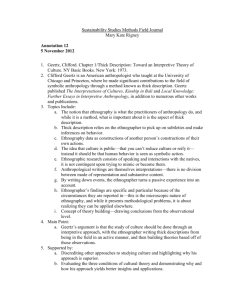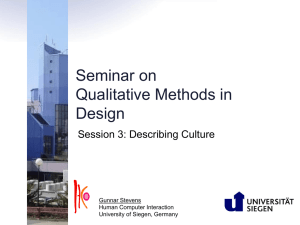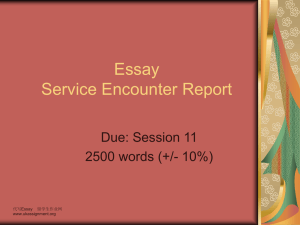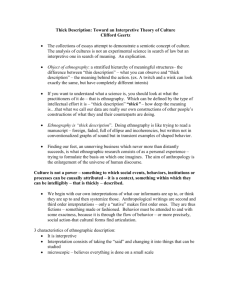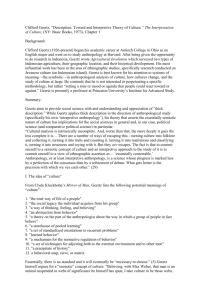Religious Studies II - Mr. Mulé`s Religion Pages
advertisement
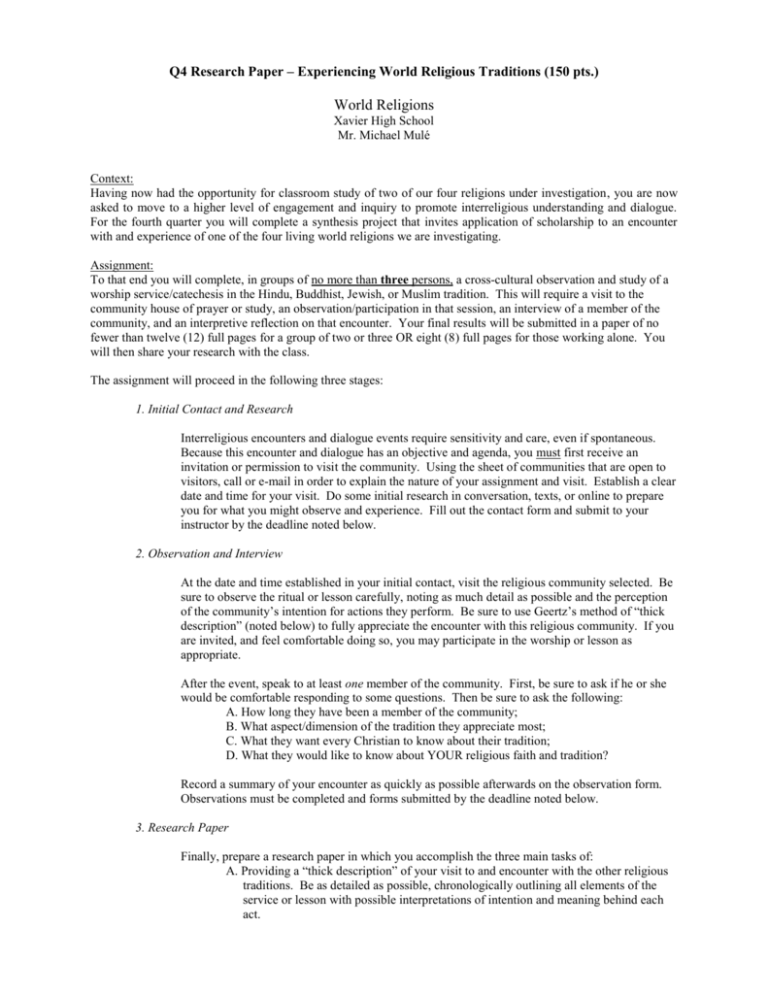
Q4 Research Paper – Experiencing World Religious Traditions (150 pts.) World Religions Xavier High School Mr. Michael Mulé Context: Having now had the opportunity for classroom study of two of our four religions under investigation, you are now asked to move to a higher level of engagement and inquiry to promote interreligious understanding and dialogue. For the fourth quarter you will complete a synthesis project that invites application of scholarship to an encounter with and experience of one of the four living world religions we are investigating. Assignment: To that end you will complete, in groups of no more than three persons, a cross-cultural observation and study of a worship service/catechesis in the Hindu, Buddhist, Jewish, or Muslim tradition. This will require a visit to the community house of prayer or study, an observation/participation in that session, an interview of a member of the community, and an interpretive reflection on that encounter. Your final results will be submitted in a paper of no fewer than twelve (12) full pages for a group of two or three OR eight (8) full pages for those working alone. You will then share your research with the class. The assignment will proceed in the following three stages: 1. Initial Contact and Research Interreligious encounters and dialogue events require sensitivity and care, even if spontaneous. Because this encounter and dialogue has an objective and agenda, you must first receive an invitation or permission to visit the community. Using the sheet of communities that are open to visitors, call or e-mail in order to explain the nature of your assignment and visit. Establish a clear date and time for your visit. Do some initial research in conversation, texts, or online to prepare you for what you might observe and experience. Fill out the contact form and submit to your instructor by the deadline noted below. 2. Observation and Interview At the date and time established in your initial contact, visit the religious community selected. Be sure to observe the ritual or lesson carefully, noting as much detail as possible and the perception of the community’s intention for actions they perform. Be sure to use Geertz’s method of “thick description” (noted below) to fully appreciate the encounter with this religious community. If you are invited, and feel comfortable doing so, you may participate in the worship or lesson as appropriate. After the event, speak to at least one member of the community. First, be sure to ask if he or she would be comfortable responding to some questions. Then be sure to ask the following: A. How long they have been a member of the community; B. What aspect/dimension of the tradition they appreciate most; C. What they want every Christian to know about their tradition; D. What they would like to know about YOUR religious faith and tradition? Record a summary of your encounter as quickly as possible afterwards on the observation form. Observations must be completed and forms submitted by the deadline noted below. 3. Research Paper Finally, prepare a research paper in which you accomplish the three main tasks of: A. Providing a “thick description” of your visit to and encounter with the other religious traditions. Be as detailed as possible, chronologically outlining all elements of the service or lesson with possible interpretations of intention and meaning behind each act. B. Relating the encounter with an individual member of the community. Be sure to note what questions you asked and his/her responses. If your interlocutor asked you any questions, be sure to note those as well as your responses. Be sensitive to the emotions you felt at the time of the interview, as well as how you feel reflecting on that conversation now. Did your appreciation of the religion grow as a result of the interview? Why or why not? C. In light of your observation and interview, compare at least five of the religious dimensions of the other religions with that of Roman Catholic Christianity. What are points of confluence (similarities) and points of divergence (differences)? How does this aid or hinder your understanding or appreciation of each tradition? Also reflect and note if and how this encounter has helped you appreciate your own religious patrimony or not. Papers must be no fewer than eight (8) or twelve (12) pages in proper MLA format with proper citations and page of works cited. You may divide up the work among members of the group and assemble the sections into a cohesive final draft for submission; however, the paper grade will be assigned uniformly to all members of the group. Be sure to have an adequate introduction that outlines the project and its method of completion, as well as a conclusion that recapitulates the key themes and presents questions or areas for further inquiry. Methodology: When entering into a cultural context with which one is unfamiliar, one need be careful and deliberate in the approach and method used. Cultural anthropologist Clifford Geertz of Princeton University’s Institute for Advanced Study recommends the use of “thick description” in the encounter and study of foreign cultures in order to observe not only the superficial, empirical activities of the community and its members, but also interpret the meaning and relationships among those actions to understand really “what’s going on”. A summary of Geertz’s work explains: We must proceed interpreting a culture’s web of symbols by 1. isolating its elements 2. specifying the internal relationships among those elements 3. characterize the whole system in some general way—according to the core symbols around which it is organized, the underlying structures of which it is a surface expression, or the ideological principles upon which it is based (17). We must, however, be careful that such hermeneutical approaches might actually distance us from cultural analysis’s proper object, “the informal logic of actual life… Whatever, or wherever, symbol systems ‘in their own terms’ may be, we gain empirical access to them by inspecting events, not by arranging abstracted entities into unified patterns” (17). Therefore, coherence cannot be a test for a cultural interpretation’s validity. While cultural systems must have a certain degree of coherence in order to be cultural systems, coherence is a loaded measurement as well as a limited one. “Tightness” of a culture, or at least its interpretation, makes for neither a valid or invalid interpretation. Rather, the ethnographer ‘inscribes’ social discourse, turning a passing event into an account. Guessing at meanings is a given in the interpretations behind the inscriptions. “Tightness” is irrelevant for the most part. In Geertz’s understanding, ethnography is by definition “thick description”—“an elaborate venture in.” Using the action of “winking,” Geertz examines how—in order to distinguish the winking from a social gesture, a twitch, etc.)—we must move beyond the action to both the particular social understanding of the “winking” as a gesture, the mens rea (or state of mind) of the winker, his/her audience, and how they construe the meaning of the winking action itself. “Thin description” is the winking. “Thick” is the meaning behind it and its symbolic import in society or between communicators. Ethnographic description includes the following: 1. it’s interpretive 2. what it is interpretive of is the flow of social discourse 3. the interpreting involved consists in trying to rescue the ‘said’ of such discourse from its perishing occasions and fix it in perusable terms (20). He compares the method of the “interpretive anthropologist” (who accepts a semiotic view of culture) with the method of the literary critique analyzing a text: “Analysis, then, is sorting out the structures of signification—what Ryle called established codes—and determining their social ground or import… Doing ethnography is like trying to read (in the sense of ‘construct a reading of’) a manuscript.” Additionally we should treat human behavior as “symbolic action—action, which, like phonation in speech, pigment in painting, line in writing, or sonance in music, signifies—the question as to whether culture is patterned conduct or a frame of mind, or even the two somehow mixed together, loses sense. The thing to ask is what their import is.” (9-10) (my emphasis) Approaching culture as either subjective/objective, modern/traditional or designated by and supposed social dichotomy is dangerous and misleading. We should, rather, view human behavior as “symbolic action.” Culture is public because “meaning is,” and systems of meanings are what produce culture, they are the collective property of a particular people. When “we,” either as researchers or simply as human beings, do not understand the beliefs or actions of persons from a foreign culture, we are acknowledging our “lack of familiarity with the imaginative universe within which their acts are signs.” (12-13) We cannot discover the culture’s import or understand its systems of meaning when, as Wittgenstein noted, “We cannot find our feet with them.” (13) Therefore, when faced with “a multiplicity of complex conceptual structures, many of them superimposed upon or knotted into one another, which are at once strange, irregular, and inexplicit,” the ethnographer must attempt to grasp and interpret them, striving to understand how and why behavior is shaped in such and such a way (as opposed to another). Thick description is, thus, much more that mere data collection although this is an inherent part of anthropological work as well. You must use “thick descriptions” when you write about what you observe. Be sure to use objective, respectful language consonant with the goals of religious studies and inter-religious dialogue. If necessary, identify personal bias to clarify your perspective. All papers must be written and formatted in proper MLA format. Consult the Purdue Online Writing Lab or the instructor if you have any questions (http://owl.english.purdue.edu/owl/resource/747/01/). Deadlines: 1 May 2015 (H, Friday) 12 May 2015 (F, Tuesday) 15 May 2015 (B, Friday) - Contact Form Observation Form Final draft uploaded to Turnitin.com (25pts.) (25 pts.) (100 pts.) The Contact and Observation Forms are due in class; the final paper is due at 4:00pm on the date noted. Any late forms or papers will be assessed a minimum 20% penalty if less than 48 hours late. Papers receive a minimum 40% penalty if more than 48 hours late. If you have any questions, please see instructor ASAP. Enjoy your research and observations! Contact Form Due: May 1, 2015 Group Members: 1. ________________________________________ 2. ________________________________________ 3. ________________________________________ Information on Religious Community to Visit Date of Contact Person Contacted Method of Contact Community Name Street Address: City, State, and Zip Code Phone Number E-mail Address (if applicable) Date and time you will visit community: Mode of transportation to site: __________________________________________ ________________________________________________ Pre-Reflection on Community Visit 1. What was your group’s motivation for selecting the religious community you will visit? 2. What at present do you know about the religious tradition you will visit and observe? By what means did you learn about it? What is most interesting? (Be as precise and specific as possible.) 3. Can you identify any potential problems or biases in your openness to the community and its members? If so, how do you plan to deal them? 4. What do you hope/expect to observe and experience at the community? Observation Form Due: May 12, 2015 Group Members: 1. ________________________________________ 2. ________________________________________ 3. ________________________________________ Information on Religious Community Visited Community Name Street Address: City, State, and Zip Code Phone Number E-mail Address (if applicable) Name of Community Leader Date and time you visited community: __________________________________________ Record of Community Visit Running record of actions observed and interpretation of potential meaning: Action Observed Interpretation of Intention and Meaning Action Observed Special Notes: Interpretation of Intention and Meaning Transcript of Interview with Member of Community: Name of Community Member: ____________________________________________________ How long a member of that community? ____________________________________________ Question Asked Response Special Notes: (Include here any questions you were asked and your response.)


